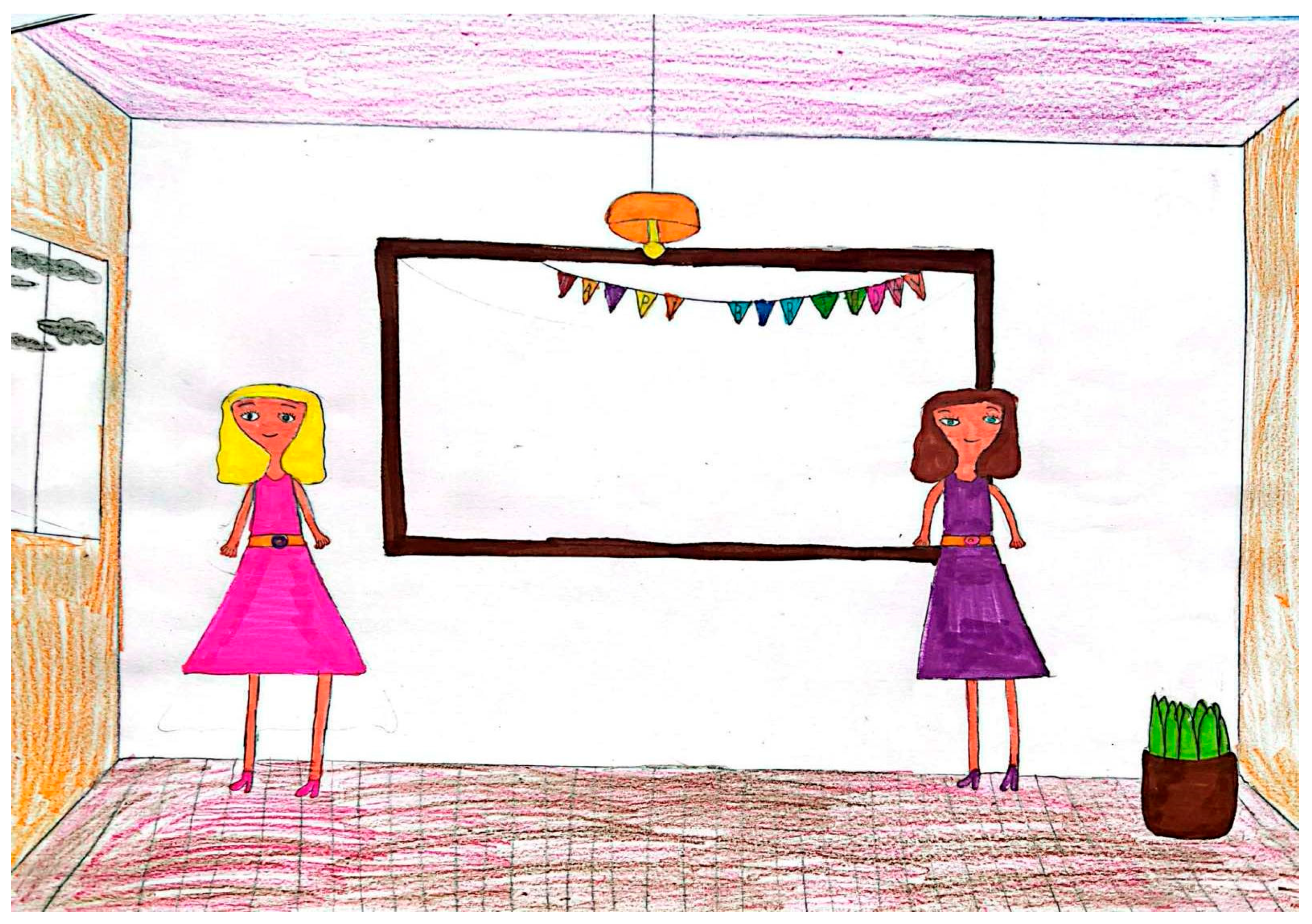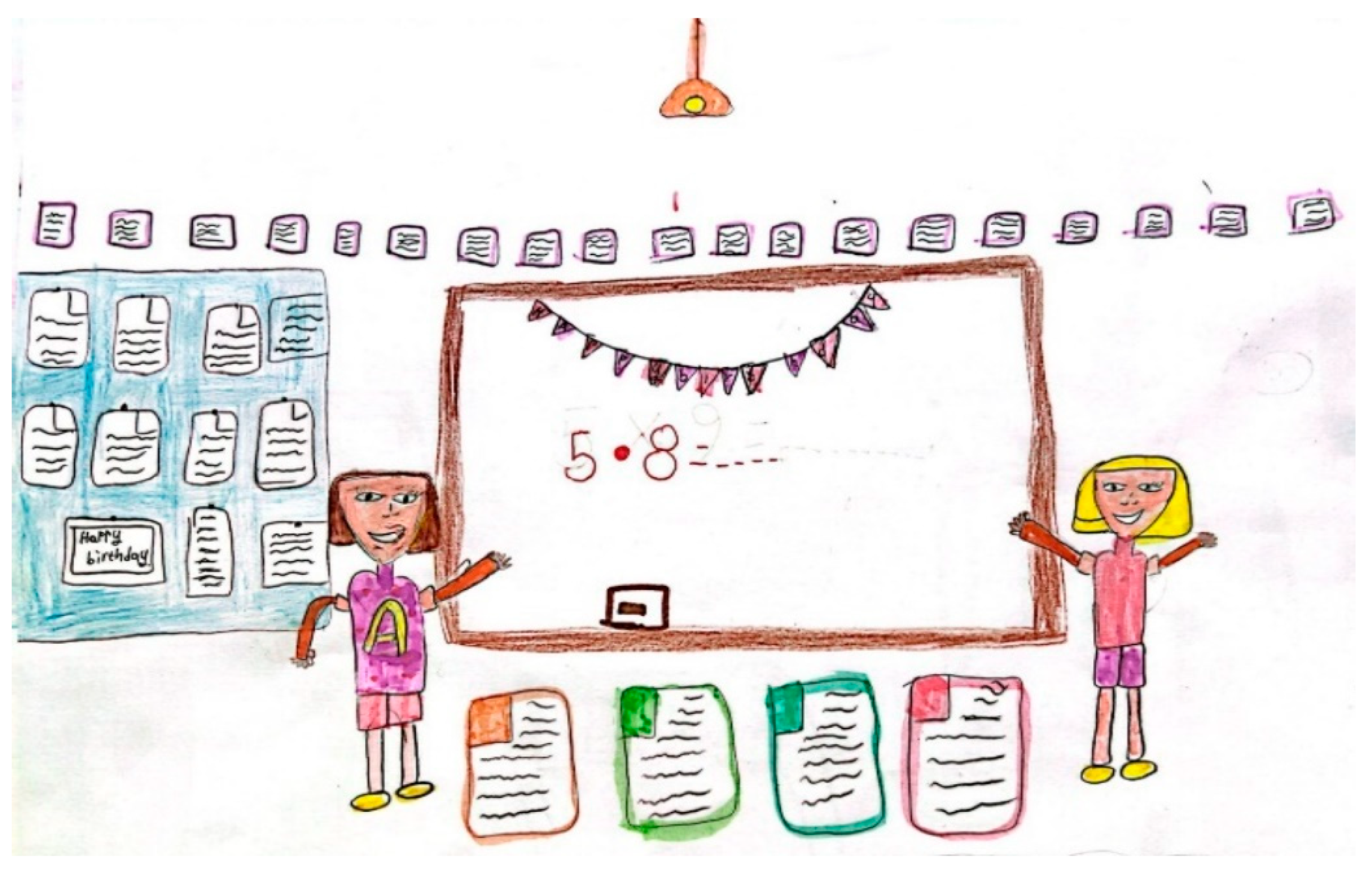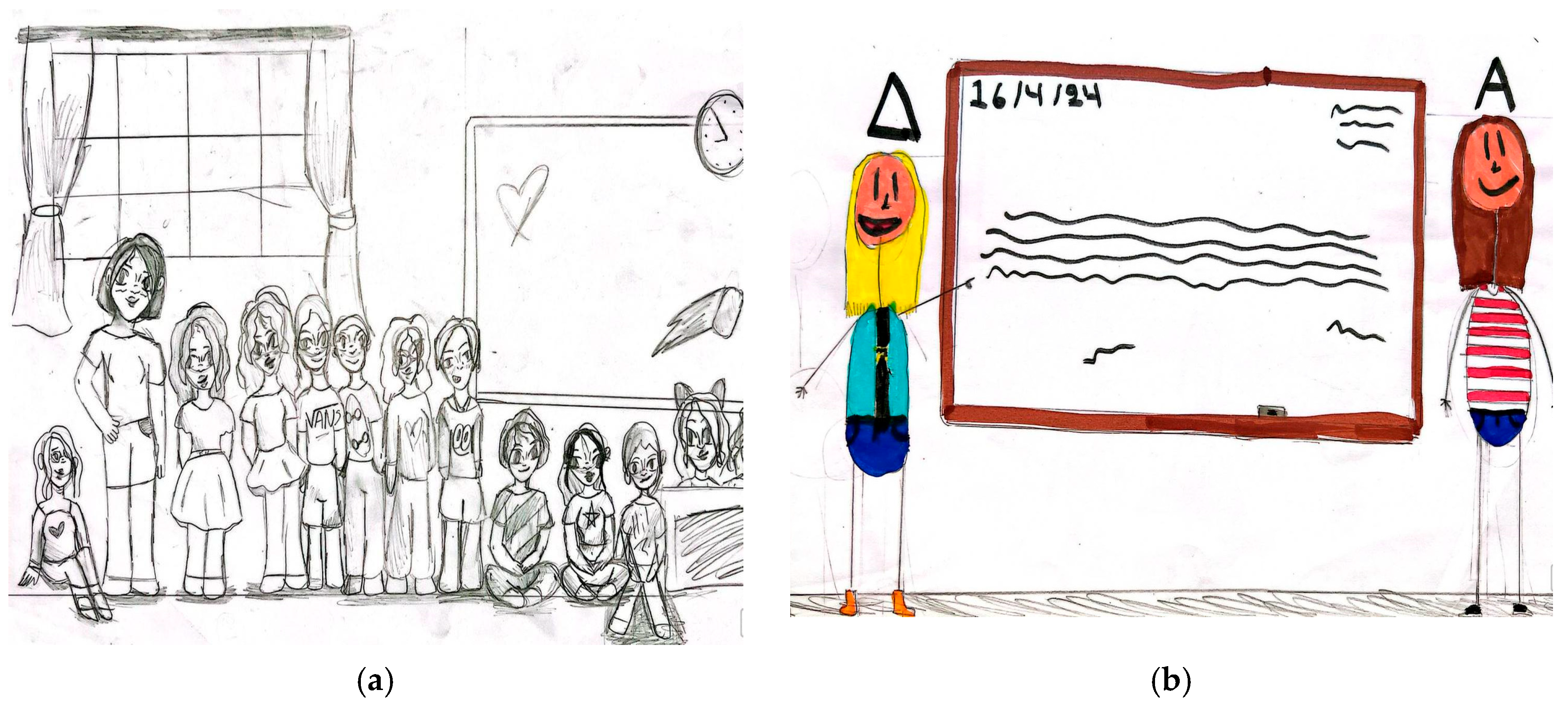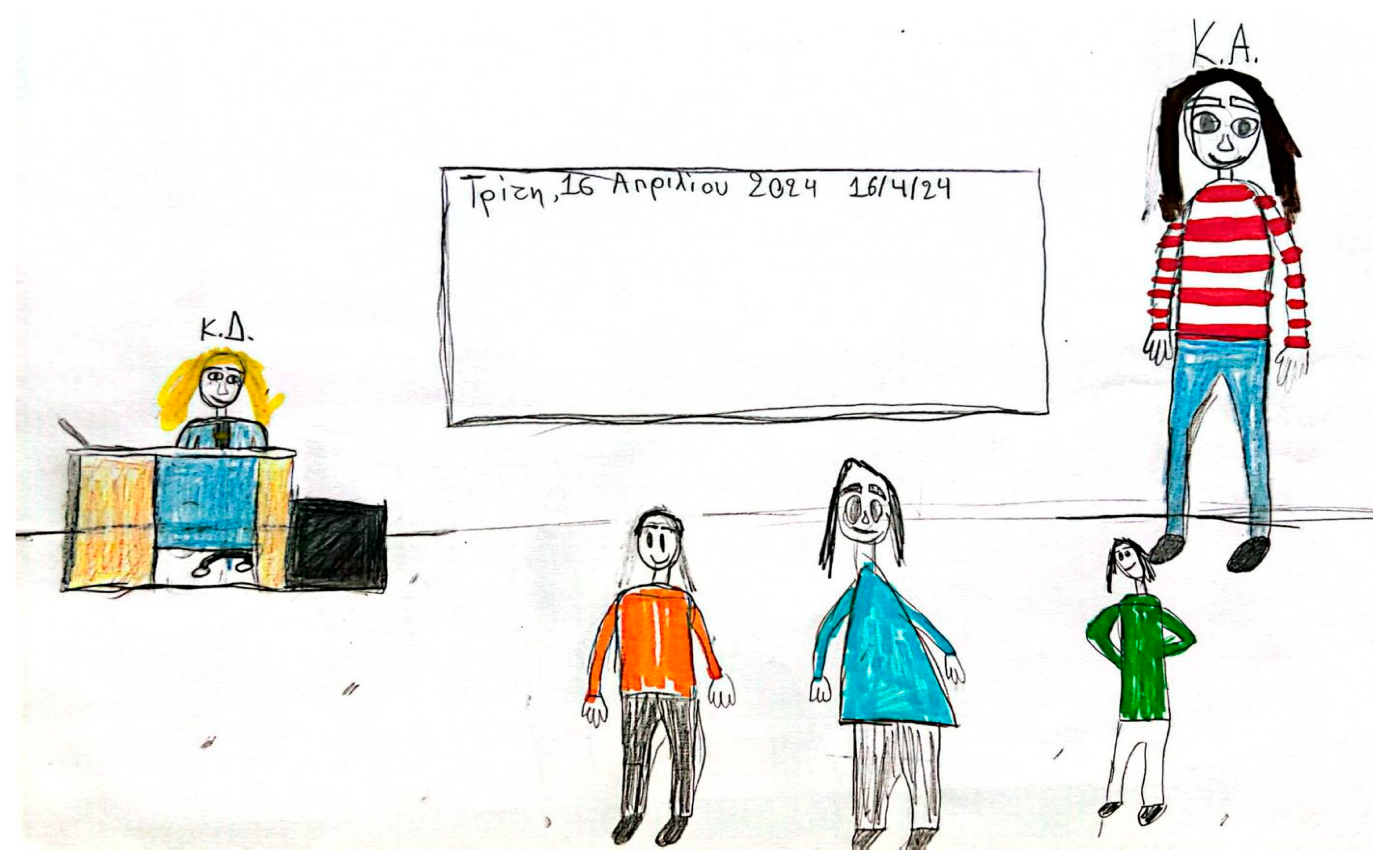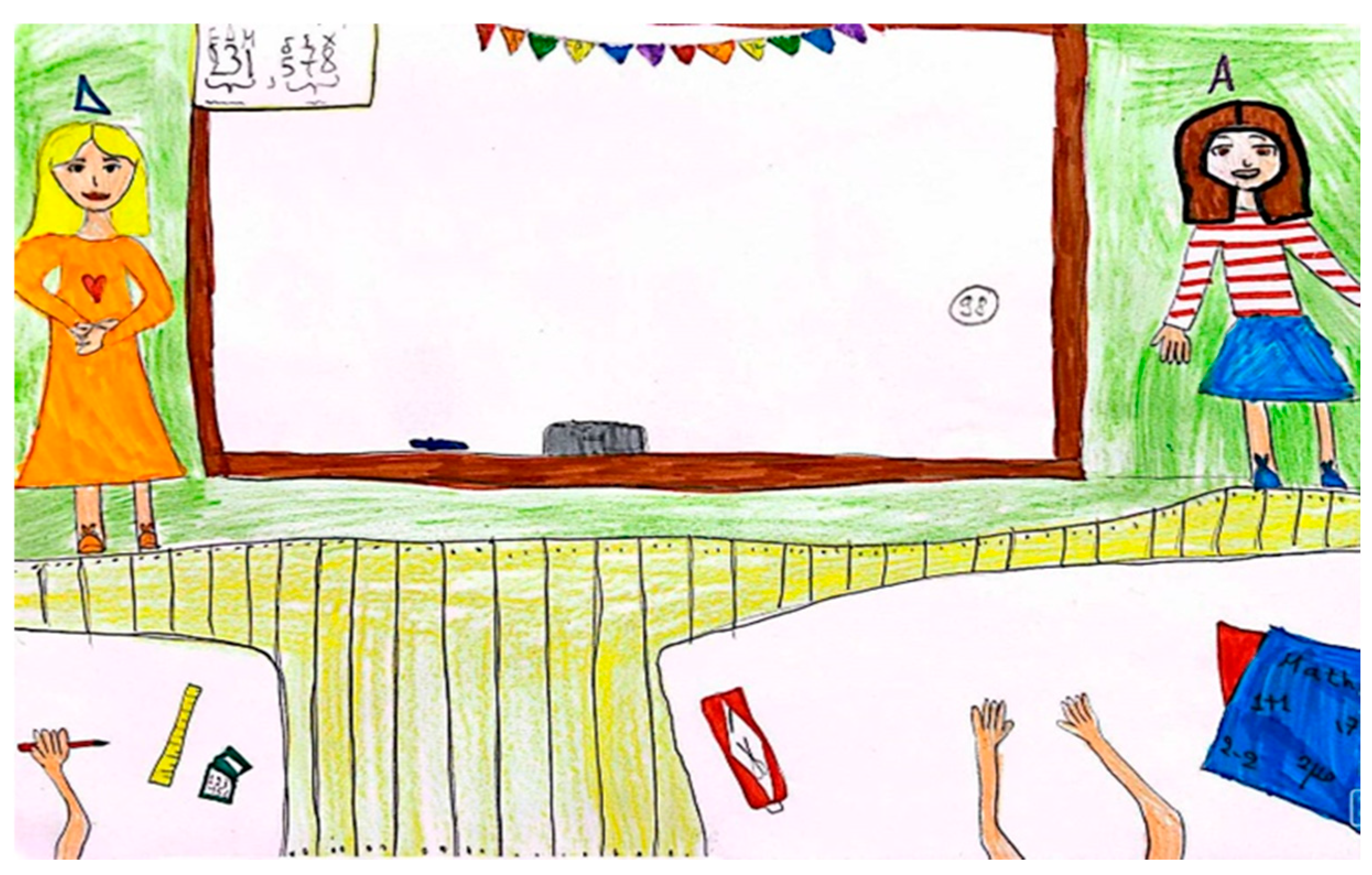3. Results
3.1. First Aim of the Study: Students’ Perceptions About the Role and Duties of Co-Teachers in the Classroom
Table 1 presents the students’ perceptions about the role and responsibilities of the co-teachers in the mainstream classroom. The majority of the students reported that they learn better from the GET (60%) and both teachers (36.2%) (item 1). Regarding teaching issues (items 2 to 5), the majority of the students perceive the GET as the main figure who plans, teaches, and assesses in the classroom, while the next bigger percentage was that both educators were perceived as such. When comparing students with and without SEN, significant differences were observed in several items. Specifically, the students without SEN (63.2%) mentioned that they learn better with the GET, while students with SEN mentioned that they learn equally well with both teachers (43.8%) followed by the GET alone (37.5%) [χ
2(2) = 9.07,
p = 0.008; Cramer’s V = 0.53; 95% CI [2.28–3.33] for students without SEN; [1.33–2.16] for students with SEN]. Students without SEN considered that the GET is responsible for grading their assignments (88.6%), while students with SEN stated that they receive their grade from the GET or both teachers (GET: 62.5%, Both: 31.3%) [χ
2(2) = 9.28,
p = 0.006; Cramer’s V = 0.97; 95% CI [3.0–3.93] for students without SEN; [2.24–3.0] for students with SEN]. In the statement about who is responsible for the instruction materials, students without SEN indicated the GET (76.3%), while SEN students indicated the GET (50%) and both teachers (31.3%) [χ
2(2) = 8.02,
p = 0.013; Cramer’s V = 0.36; 95% CI [2.74–3.50] for students without SEN; [1.56–2.55] for students with SEN]. In the item about who seems to plan most of the lessons, almost all students without SEN indicated the GET (93%), while the opinions of students with SEN were divided; 43.8% indicated the GET, 37.5% indicated the SET, and 18.8% indicated both teachers [χ
2(2) = 26.95,
p < 0.001; Cramer’s V = 0.68; 95% CI [3.16–3.71] for students without SEN; [0.97–1.40] for students with SEN].
Figure 1 below displays proportions (%) of responses to item 4 targeting children’s perception of the person(s) in charge of lesson planning in class.
Regarding the items on teaching support, the majority of the students stated that they ask for help from both teachers (58.5%), and also indicated the GET as the person who explains things most of the time (80.8%) or explains things in different ways (60%). Students’ responses were divided among the three options in items 7 and 10 (these items targeted who walks around the classroom helping the students and who explains things when a student makes mistakes). Significant differences between students with and without SEN were observed in items 6 and 10. Specifically, students with SEN stated that they turn for help mainly to the SET (50%), while students without SEN ask for help from both teachers (61.4%) [χ2(2) = 12.73, p < 0.001; Cramer’s V = 0.45; 95% CI [2.52–3.10] for students without SEN; [1.61–2.38] for students with SEN]. The teacher who explains things when children make mistakes during the lesson is the GET for students without SEN (48.2%), while students with SEN indicated both teachers (50%) and the SET (31.3%) [χ2(2) = 8.19, p = 0.015; Cramer’s V = 0.20; 95% CI [2.0–2.87] for students without SEN; [1.56–2.43] for students with SEN].
3.2. Second Aim of the Study: Students’ Perceptions of Co-Teaching in Terms of Equivalence, Classroom Atmosphere and Ways of Learning
Regarding students’ perceptions about aspects of co-teaching, data from
Table 2 indicate that most students strongly disagreed (21.5%) or disagreed (43.5%) that teachers divide the lesson in half to have equal amount of work. A similar pattern (i.e., disagreement) was exhibited about the statement that ‘One teacher is more responsible for our behaviour and the other teacher is more responsible for the lesson’. A great percentage of students (26.9% agreed; 48.5% strongly agreed) converged on the statement that both teachers are equal in the classroom (item 3). When comparing students with and without SEN, a significant difference was revealed in the statement about whether teachers in the co-taught classroom divide the lesson in half to do the same amount of work [χ
2(3) = 7.37,
p = 0.047; Cramer’s V = 0.90; 95% CI [1.28–2.33] for students without SEN; [1.69–2.55] for students with SEN]. More specifically, as one can see in
Figure 2 below, half of the students with SEN seemed to strongly disagree, while students without SEN seemed to have rather milder objections to the statement.
Regarding classroom atmosphere, almost all students seemed to agree or strongly agree with statements 4 and 5, i.e., ‘Teachers like to teach in a co-taught classroom’, and ‘Students like to have two teachers’, respectively. Similarly, students agreed (44.6%) or strongly agreed (23.8%) that teachers feel comfortable sharing responsibilities when teaching together. Responses were more mixed and distributed across options for the statement that ‘students behave better when there are two teachers in the classroom’.
As far as the way students learn, most students agreed (33.8%) or strongly agreed (39.8%) that they learn better when they have two teachers in the classroom. When comparing students with and without SEN, a statistically significant difference was found [χ2(4) = 10.43, p = 0.023; Cramer’s V = 0.47; 95% CI [2.08–3.29] for students without SEN; [2.77–3.85] for students with SEN], which stemmed from the fact that a greater percentage of students with SEN expressed a preference for two teachers in comparison to the students without SEN (item 9). In addition, students also agreed (40%) or strongly agreed (38.5%) that teachers in the co-taught classroom use more teaching strategies in comparison to the non-co-taught classroom (item 10). Responses were more mixed for statement 11 that ‘One of the teachers explains things to me better than the other’ (students’ responses were distributed across all options). Although many students wished all their classes had two teachers (61.3%), some students disagreed (37.7%). In addition, some students felt hard or experienced confusion having two teachers (65.4%), while some students didn’t feel the same way (34.6%).
3.3. Third Aim of the Study: Students’ Conceptualization of Co-Teaching in Drawings
Regarding inter-rater agreement and reliability, of the 130 drawings, a sample of 30 randomly identified (23%) were evaluated by the first author of the study (first rater). To assess the inter-rater agreement, the same sample was re-scored a week after by a second rater (the third author), who was blind to the original scoring. Each rater coded each drawing in all the categories, separately for the GET and the SET. Inter-rater reliability was assessed by calculating Cohen’s kappa coefficient (κ 95% confidence limit). The results showed excellent agreement for both the GET (99.3% agreement, κ = 0.95) and the SET category (100% agreement, κ = 1.00).
Students’ drawings give insights into how children conceptualize co-teaching. They were joyful, creative, detailed, depicting scenes within the classroom. The majority of the students drew their teachers as ‘female’, (76.2% and 69.2% for the GET and the SET, respectively) (
Figure 3), while male figures were less frequent (GET: 10.8%; SET: 23.1%). In addition, 13.1% of the students depicted the GET with an unspecified gender, using faces or heroes, while this tendency was encountered to a smaller extent (7.7%) respectively for the SET (
Table 3).
Physical appearance of the teacher was one of the themes examined in children’s drawings (
Table 4). Findings showed that 38.5% of the students drew the GET in ‘a skirt or dress’, while 26.9% preferred to draw him/her as a figure without clothes. In addition, a slightly lower percentage (26.9%) of students drew the SET in ‘a dress or skirt’, while 31.5% of the students drew him/her as a simple figure without clothing. The remaining characteristics had lower percentages.
Figure 4a,b depict drawings which are representative of the physical appearance of the teachers.
Teachers’ facial expressions in children’s drawings are shown in
Table 5. Students depicted the GET and SET mainly as being happy (GP: 29.2% versus 32.3%), smiling (28.5% v. 34.6%), or with no discernible facial expression (16.9% v. 21.5%), thus showing an overall positive social representation of the teachers (
Table 5).
Figure 5 shows the teachers being happy and cheerful.
Physical characteristics of the teachers are presented in
Table 6. The GET is depicted mainly with well-groomed hair (30%), or with no physical characteristics (24.6%), while the SET is usually depicted at a young age (37.7%), with no physical characteristics (32.3%), followed by well-groomed hair (16.9%). In
Figure 6, the GET (human figure on the left) has well-groomed hair, while the SET (human figure on the right) looks younger. It seems that teachers are positively perceived by students in terms of physical appearance.
The analysis of the size of the teachers in the drawings shows that most students captured GET (53.1%) and SET (57.7%) in their actual size in the classroom (
Table 7). However, several students drew them larger than their actual size (GET: 38.5%, SET: 33.8%).
Figure 7a shows a real-life size ratio, while
Figure 7b shows teachers in a larger size than in real life. A possible reason for this discrepancy may be that bigger size reflects children’s respect towards the teacher as an important figure, while real size reflects a rather balanced, realistic approach.
The study also examined the physical actions of teachers, and relevant findings are reported in
Table 8. One can see that students mainly drew the GET standing (53.8%) or teaching (28.5%), while the SET often stands (36.9%), walks around the classroom (26.2%) or sits close to a student (27.7%) This pattern is in accordance with the ‘one teach, one assist’ model. In
Figure 8, the GET teaches Mathematics, while the SET stands close to a student.
Table 9 indicates the objects teachers held in the drawings. The majority of the students drew GET (76.2%) and SET (97.7%) without holding objects. Those who painted the GET holding something usually drew her/him as holding a marker (11.5%) or a book (5.4%). In
Figure 9, both teachers are depicted to teach without holding an object. This pattern likely reflects the way children conceptualize teachers as “people first, workers second”.
Drawings of students with and without SEN were compared using the χ
2 criterion. There were significant differences between the two groups. Specifically, a considerably higher proportion of students with SEN (68.8%) tended to draw the SET at a young age compared to students without SEN (33.3%) [χ
2 (6) = 11.50,
p = 0.046; Cramer’s V = 0.42; 95% CI [0.28–0.83] for students without SEN; [0.02–0.40] for students with SEN]. In addition, 81.3% of the students with SEN drew the SET in a larger size than the actual, while only 27.2% of the students without SEN did so, with the remaining 64% depicting SETs in their actual size [χ
2 (2) = 17.64,
p < 0.001; Cramer’s V = 0.49; 95% CI [0.72–1.00] for students without SEN; [0.83–1.0] for students with SEN].
Figure 10 displays the distribution of the students’ responses across the three categories (Size: ‘larger than actual’, ‘smaller than actual’, actual), while
Figure 11 displays a drawing by a student with SEN that depicts the SET in a considerably larger size than the GET. The student’s drawing also includes him/herself and two classmates.
Figure 12 below focuses on the disposition of the teachers and the instructional setting in the classroom. One can see that the GET stands in front of the students teaching them, while the SET is next to a child touching her shoulder. A heart painted over the teacher probably indicates the expression of love from the student towards the SET.
Finally, a student without SEN drew the two teachers having equal sizes, appearing in a ‘skirt or dress’, with well-groomed hair, and standing on each side of the board (
Figure 13). This could be interpreted as the student perceiving both teachers as equal figures of authority, with the board being depicted as the shared centre of learning.
4. Discussion
The current study aimed to investigate the perceptions of primary school students with and without SEN regarding the roles, duties and cooperation of teachers in the co-taught classroom, as well as aspects of co-teaching, gathering data from students’ questionnaire responses and drawings. In relation to the first aim of the study, the findings reflect a distinction in the children’s perception of the learning gains stemming from GETs and SETs, depending on whether the children had SEN or not. Specifically, students overall perceived that they learn best from the GET and then from both teachers, although students with SEN perceived that they learn better from both teachers and then by the GET. In addition, distinctions were observed in children’s perception of the roles of the teachers, indicating a lack of a shared mental model of balanced duties across GETs and SETs; the GET is perceived as the main teacher who plans, assesses and is in charge of most lessons, while the SET has an assistive or supportive role, mainly being responsible to satisfy the individual needs of students diagnosed with disability or SEN. The above findings are in line with earlier research disclosing the SET’s role as an assistant in co-taught classrooms (e.g.,
King-Sears & Strogilos, 2018;
King-Sears et al., 2014;
Takala & Uusitalo-Malmivaara, 2012). When students with SEN were asked about teaching, planning and assessment issues, responsibilities were first assigned to the GET followed by both teachers, thus emphasizing the role of the GET as the primary authority figure in charge of the entire class and the implementation of the curriculum (
Embury & Kroeger, 2012;
King-Sears & Strogilos, 2018). This finding aligns with the co-teaching model of ‘one teach, one assist’ (
Friend et al., 2010) which is implemented by the majority of teachers in many countries, including Greece. It is worth noting here that genuine inclusion promotes co-teaching as a way to foster equality, shared responsibility and meaningful participation for all learners (
Zamkowska & Nogaj, 2024). Overall, the study’s findings highlight novel points that contribute to bridging the gap in knowledge and skills of stakeholders in inclusive education, with children’s questionnaire responses and drawings identifying specific ways in which inclusive teaching practices could be implemented more efficiently in the classroom. In terms of support, the study highlights the promising potential benefits of co-teaching when students with and without SEN are provided with equal access to both GETs and SETs. Students without SEN seem to ask for help from both teachers in the classroom, while students with SEN tend to seek help or advice primarily from the SET or from both teachers. When they make mistakes, students with SEN turn either to both teachers or the SET. This dual perception likely reflects a gradual shift from the ‘one teach, one assist’ model to a collaborative teaching practice, further suggesting that the SET could have an active role and work equally well with any student in need of assistance, and the same applies for the GET (
Strogilos & Tragoulia, 2013). As
Rönn-Liljenfeldt et al. (
2023) suggest, ‘although SETs are not the lead teachers, the ‘one teach, one assist’ co-teaching model can be effective when active support is provided to all students’ (p. 11).
The second aim of the study has examined co-teaching in terms of equity, classroom atmosphere and ways of learning. Co-teaching and sharing responsibilities were highlighted as a valuable strategy for improving learning outcomes. Specifically, according to the findings of our study, the majority of the students liked having two teachers in the classroom. Their responses also converged on the fact that the classroom atmosphere in the co-taught classroom was positive, and that both teachers were equal, sharing responsibilities for behavior and lesson management. Although the majority of the students wished to have two teachers in all the classes, some students felt confused by this condition. The above findings indicate that students from classes where co-teaching was applied mainly had positive experiences and perceptions. It is worthwhile continuing to develop the co-teaching model moving on to more effective practices (e.g., team teaching). Similar findings have been reported by previous literature (e.g.,
Strogilos & Tragoulia, 2013;
King-Sears et al., 2014;
Rönn-Liljenfeldt et al., 2023). These studies show that teachers, when doing co-teaching, enrich the learning environment through exploiting their different personality styles and their variety of teaching methods and activities. Moreover, they try to keep a calm atmosphere in the classroom. By modelling collaboration and valuing diverse learning needs, co-teaching promotes a classroom climate of fairness, inclusivity, and respect for one another (
Sharma & Salend, 2016). Furthermore, more balanced roles of teachers within the co-taught classroom would foster fairer interactions between educators and learners, leading to improved learning outcomes (
Qualls et al., 2025).
The third aim of the study has attempted to conceptualize co-teaching through drawings. The latter have provided a useful independent means of identifying student–teacher relationships in classroom, and also offered complementary data about the role and duties of GETs and SETs, opening a window into the emotional and symbolic world of the children. Students portrayed their teachers mainly as being ‘female’, a finding which is in line with most previous research (e.g.,
Arslan Cansever, 2017;
Aykaç, 2012). The presence of a significant number of female teachers in schools affect children’s perceptions because primary school children learn about gender roles by observing adults (
Bessette, 2008). In addition, students portrayed their teachers most often as appearing in ‘skirts or dresses’, while some students preferred to draw them as figures without any clothes. This can be explained by gender acquisition roles while children go through socialization processes (
Arslan Cansever, 2017). Furthermore, children represented both the GET and the SET as being ‘cheerful’, which implies that they had a positive image of them. As far as the physical characteristics of teachers are concerned, students drew the GET mainly with ‘well-groomed hair’ while the SET was consistently younger than the GET and with well-groomed hair. The latter can be explained because SETs in Greece are overall younger that the average age of permanently appointed teachers, especially since it is mainly recent university graduates that are hired each school year as ‘substitute teachers’ in the co-taught classrooms (
Koutsoklenis & Papadimitriou, 2021). In addition, children preferred to draw their teachers without holding objects, giving emphasis on the “person” and not on the “object”. While children usually draw their teachers as bigger than actual (
Aykaç, 2012), in our study the majority of the students drew their teachers in their actual size, giving a realistic representation of their figures. This can be explained in terms of the students’ chronological age, because the participants of the current study attended the upper three grades of primary school. However, when we focus on children with SEN, we see that they drew the SET in a larger size than the actual one, which further implies their admiration, respect, sense of authority or power, or their need to establish meaningful and positive relationships with him/her (
Bessette, 2008). Another finding which deserves attention is students’ level of realism in the visualization of the teachers’ disposition in the classroom. More specifically, students were found to draw the GET standing in front of the whiteboard or near his/her desk, ‘teaching and relaying information’, while the SET was frequently portrayed to walk around the classroom or sit together at the desk with a child. This finding offers support to the ‘one teach, one assist’ model.
By combining the questionnaire data with the drawing evidence, a more holistic picture of students’ perspectives of co-teaching has emerged. More specifically, while the output of the questionnaire has quantified aspects of co-teaching across the sample, the drawings have added more depth to the findings by revealing emotions, symbols and fine-grained nuances that enable a better grasp of the students’ subjective experiences within the co-taught classroom. Children’s drawings included bright colours, smiling facial expressions and well-groomed figures, thus revealing a happy, collaborative classroom atmosphere, and a positive image of GETs and SETs. Students’ ratings of co-teaching in the questionnaire have been generally positive, and this finding seems to align with the drawing evidence of the study, further implying that drawings were a particularly salient correlate of children’s perception of co-teaching practices.
To sum up, although our study reflects the ‘one teach, one assist’ model, students in the co-taught classrooms generally felt that their learning needs were being met and that they benefited from having two teachers. However, the students were sometimes spilt between the GET and both educators, especially in terms of who does what, although in general they perceived that most tasks were carried out by both educators who have been collaborating in the classroom. Students with SEN seemed to feel closer to the SET, which is also reflected in the implementation of the legislative framework of parallel support in Greek schools. Our findings are consistent with earlier Greek studies (
Mavropalias & Anastasiou, 2016;
Strogilos & Tragoulia, 2013), but it seems that there has been progress in the implementation of co-teaching over the years. This is mainly reflected in the fact that our study has shown more balanced roles for the two teachers, as well as more complementary responsibilities as compared to previous relevant research. Although children seemed to be satisfied with the co-teaching practices, we have no quantifiable data about their benefits in terms of academic progress and social development. In the past years, the Greek educational system has witnessed a tendency to move away from the model of designating a SET to one or two students, implementing a different, more balanced co-teaching system where co-teachers undertake active instructional roles (
King-Sears et al., 2014).
Finally, the present study on students’ perceptions of co-teaching can meaningfully contribute to high-quality, inclusive education that moves beyond tokenistic approaches. It can offer insights on the transition from the mere integration of students with SEN into mainstream classrooms to a “genuine inclusion”. Understanding how students in Greece perceive the effectiveness and benefits of co-teaching practices provides comparative evidence that may enrich international discussions. The current study is novel in that it reveals important avenues for exploring how students (with and without SEN) experience co-teaching practices in classroom and ways to capitalize on this pathway to promote inclusive education and the satisfaction of the students’ diverse learning needs. As reported by
Qualls et al. (
2025), in order to “understand how each partnership’s components function and what supports are needed, a view from inside the system instead of outside is needed” (p. 12).


